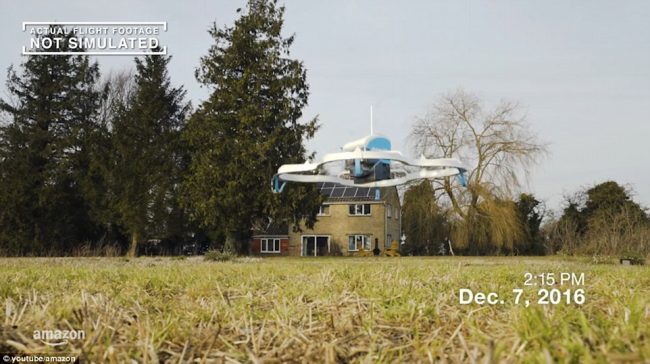The drone left one of the firm’s bases in Cambridge and dropped off an Amazon Fire TV box and a bag of popcorn to a customer in the same county, although Amazon has yet to confirm how far the aircraft travelled.
The Daily Mail reported Amazon as saying that it plans to roll out a regular drone air delivery service in the future but that it will be subject to distance and weight restrictions while customers who use it must have a large enough garden for a drone to make a landing.
Currently, the restrictions mean the drone service is only open to two customers. The products they order must also be less than 5.7lbs, with items such as Apple’s Macbook Pro weighing 4.4lbs.
Amazon does not require a licence for the drones but once it rolls out the service further it will need to obtain the permission of the Civil Aviation Authority for every delivery as all commercial drone flights must be approved by the body.
Amazon said a new private trial will now deliver packages up to five pounds in weight in 30 minutes.
First-ever #AmazonPrimeAir customer delivery is in the books. 13 min—click to delivery. Check out the video: https://t.co/Xl8HiQMA1S pic.twitter.com/5HGsmHvPlE
— Jeff Bezos (@JeffBezos) December 14, 2016
The US tech giant’s billionaire founder Jeff Bezos confirmed the delivery in a tweet earlier today and posted a slick video of the drone’s debut.
He wrote: ‘First-ever AmazonPrimeAir customer delivery is in the books. 13 min – click to delivery.’
In the short clip the drone was launched off a mechanised track from its Prime Air Fulfillment Centre in Cambridge, before soaring to an altitude of 400ft to deliver the package.
However, while the video looks impressive the firm is yet to release details revealing how far the drone’s launch point was from its delivery destination.
In the short clip the drone was launched off a mechanised track from its Prime Air Fulfillment Centre in Cambridge, before soaring to an altitude of 400ft to deliver the package.
Although, it is believed the drone was tested in a field near Worsted Lodge, eight miles south of Cambridge. The research and development site for Amazon UK is also in Cambridge.
Questions also remain over how the delivery drone will identify the exact garden to deliver to and whether customers will have to register separately for the service using their address.
The firm is also yet to confirm the minimum garden size needed to accommodate a delivery.
Amazon has previously said it would like to roll out the drone delivery service by the end of 2017.
Amazon plan to roll out the service more widely in the future but said customers would only be able to use drones, pictured, if they had a large enough garden, lived close enough to a depot and ordered goods that weighed less than 5.7lbs
The firm said its drones will use ‘sense and avoid’ technology and data will be continuously gathered throughout the trial to make improvements
In July the CAA lifted strict drone flying restrictions to enable Amazon to start testing its drones.
It means Amazon is allowed to have one pilot controlling multiple autonomous drones and can operate the aircraft without a direct line of sight.
Amazon said a new private trial will now deliver packages up to five pounds in weight in 30 minutes or less using the drones, which it began testing in the UK earlier this year.
However, the firm has said that the trial will only be available to a small number of customers in the Cambridge area for the time being.
Questions over the safe use of drones remain, however, with a number of near-misses involving commercial aircraft and amateur drone pilots reported this year.
Amazon has proposed using its crafts in ‘segregated blocks of airspace below 500 feet and away from most manned aviation operations’.
Meanwhile the customer in Cambridge was happy to find his Amazon Fire TV box and popcorn, pictured, had arrived in one piece
The firm also said its drones will use ‘sense and avoid’ technology and data will be continuously gathered throughout the trial to make improvements, calling safety its ‘top priority’.
The company added that the current trial was only permitted to operate during daylight hours with low winds and good visibility, and not in rain, snow or icy conditions.
On its website Amazon said: ‘It looks like science fiction, but it’s real. One day, seeing Prime Air vehicles will be as normal as seeing mail trucks on the road.’
Earlier this year Amazon got British approval for three new types of tests, including flying drones that are no longer within sight of their operators in rural and suburban areas.
The other two are having one person operate several highly automated drones and testing devices to make the drones able to identify and avoid obstacles.
